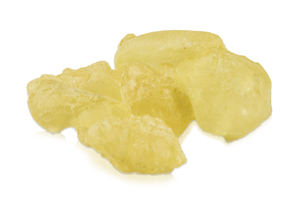INGREDIENT SPOTLIGHT: MASTIC
In the early days of Marx Foods, we had a brick-and-mortar retail shop in Seattle stocked with a selection of pantry items gathered from all over the world and painstakingly curated after extensive tasting panels. One of those items was mastic, a fascinating ancient ingredient from the Mediterranean that captivates many who have been lucky enough to procure some and taste it. While MarxFoods.com no longer sells mastic, we thought you might be interested to know about it.
Mastic’s Origins
Mastiha, as the Greeks call it, is a natural resin that has been harvested from wild pistachio trees on the island of Chios for centuries. The “modern” method for its cultivation dates to Genoese rule of the island – starting sometime around 1346 CE. All sorts of health benefits have been attributed to consuming mastic over the centuries, and it has become part of the culture in the Mediterranean and parts of the Middle East.
Various rulers extracted a tithe of mastic from the island over time – some sultans reserved it for themselves and their harems. Like all good ultra-luxury items of the ancient world, theft of mastic was once punishable by some draconian methods, up to and including death. Today things are more relaxed, but mastiha production is still limited to 24 villages on the island of Chios and protected by European Union PDO (Protected Designated Origin) status.
How Mastic Is Made
It takes five years of growth before the mastic tree (aka schinos – Pistacia lentiscus var. Chia) is ready to be harvested from. A layer of finely pulverized rock is poured around the base of the tree to catch the sap, then a series of cuts are made in the trunk.
Sap flows from these cuts and is scraped from the tree. It falls onto the rock and slowly sets into a resin over the course of 15-20 days, forming translucent gem-like pieces called “tears”. They have a different texture depending on their size. Large and medium mastic tears can be chewed, while the small tears are reserved for crushing or grinding for use as a spice. During the gathering and washing process, the tears are graded into different sizes for sale.
How Does Mastic Taste?
Chewing mastic for the first time is a fascinating experience. The translucent gem of mastic changes into what looks like white chewing gum. It starts out crumbly, and almost unbearably bitter, enough to make you think you’ve made a horrible mistake. As you chew, it transforms into a smooth, dense gum, the bitterness giving way to a piney, resinous flavor that hangs on much longer than a standard piece of modern chewing gum. The chew is firm, but pliable. In the end, mastic leaves your mouth feeling clean and refreshed.
Anissa Helou, acclaimed chef and award-winning author of “Feast: Food of the Islamic World” says mastic is one of those ingredients whose flavor is very difficult to describe. “I like to say exotic, mysterious but it doesn’t really mean much. Still, if you don’t add it to, for instance, milk ice cream or muhallabiyeh (milk pudding) you immediately notice something is missing. At least I do.”



Comments 4
Wow, this one brought me back in time! I’m Armenian on my mother’s side, and I remember her always having a container in the spice cabinet when I was growing up. As I recall, we chewed it with a bit of paraffin.
So glad you enjoyed it Chris! I really am fascinated with the stuff. Interesting that you guys chewed it with paraffin…I guess that helped smooth out the texture and flavor?
Thanks for reading!
Matthew
Marx Foods
It’s been so long, I can’t remember for sure, but I think the paraffin was kind of a buffer between your teeth and the mastic until you got it going because it was so hard a first. I’m very curious now about it’s application as a spice. I’ll have to look into that further.
I’ve put everything I know about using it as a spice on the product page‘s recipes & tips tab, if that helps. So far we’ve tried using it in the test kitchen to infuse a sorbet base (we also used yuzu juice in the same recipe). It worked rather well! The recipe will be going up on the blog sometime in December.
Matthew
MarxFoods